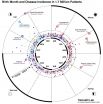(Press-News.org) The global movement patterns of all four seasonal influenza viruses are illustrated in research published today in the journal Nature, providing a detailed account of country-to-country virus spread over the last decade and revealing unexpected differences in circulation patterns between viruses.
In the study, an international team of researchers led by the University of Cambridge and the Fred Hutchinson Cancer Research Center, and including all five World Health Organization (WHO) Influenza Collaborating Centres, report surprising differences between the various types of seasonal flu virus, which they show to be due to the rate at which the different viruses evolve.
There are four types of influenza viruses that cause seasonal flu in humans: two influenza A viruses (H3N2 and H1N1) and two influenza B viruses (Yamagata and Victoria). While H3N2 viruses are the most common of the seasonal influenza viruses, H1N1 and B viruses also cause epidemics worldwide each year, hence the WHO selects representative strains of all four A and B viruses for inclusion in the seasonal influenza vaccine each year.
Importantly, all four of the viruses cause indistinguishable symptoms and evolve by similar mechanisms to escape immunity induced by prior infections and vaccinations. This 'antigenic' evolution is part of why people get influenza multiple times over the course of their lives.
In 2008, an international team led by scientists from the University of Cambridge, writing in the journal Science, showed that H3N2 viruses circulate continuously in East and Southeast Asia throughout the year, spreading to the rest of the world each year to cause seasonal flu epidemics. Given the fundamental similarities between H3N2, H1N1, and B infection it was thought that they would also emerge from east and southeast Asia to cause yearly epidemics worldwide. However, the work published today in Nature shows that in fact, H1N1 and B viruses behave very differently from H3N2 viruses.
Senior author Dr Colin Russell, from the Department of Veterinary Medicine at the University of Cambridge, UK, says: "While H3N2 viruses die out between epidemics and new viruses emerge from east and southeast Asia every year, H1N1 and B viruses frequently circulate continuously between epidemics worldwide. This continuous circulation gives rise to a huge diversity in H1N1 and B viruses circulating globally."
Interestingly, the researchers found that sometimes new H1N1 and B variants emerge from outside east and southeast Asia and are subsequently seeded into Asia, while in other cases H1N1 and B variants circulate in Asia for years without spreading globally.
"It's really surprising to find that the H3N2 viruses are unique among the seasonal influenza viruses," adds first author Dr Trevor Bedford from the Fred Hutchinson Cancer Research Center in Seattle, USA. "It's almost as surprising to find that the differences among viruses are associated with a simple phenomenon: how quickly the viruses evolve antigenically."
The Nature study finds that the rate of global movement of each virus, and its ability to circulate continuously between epidemics, is shaped by how quickly that virus changes its coat to escape immunity in the human population. Viruses that evolve quickly, in particular H3N2, spread around the world rapidly, but die out quickly between epidemics. Viruses that evolve more slowly, like H1N1 and B viruses, spread around the world more slowly but are also better at circulating continuously between epidemics.
The key element about global movement is who is getting infected: faster evolving viruses, like H3N2, can infect adults, who tend to travel more frequently than children, providing more opportunities for the virus to spread. Conversely, more slowly evolving viruses, such as H1N1 and B viruses, primarily infect children. Children get sick with all four seasonal flu viruses, but H3N2 evolves faster so it infects adults more often. This leads to a greater proportion of adult infections with H3N2 relative to H1N1 and B viruses, and faster spread of H3N2 viruses.
"Ultimately, this means that we can look at the viruses circulating in Asia to get a good idea of which H3N2 virus might spread worldwide, but for H1N1 and B it's tremendously variable and the dominant variant can vary from one region of the world to another," says Dr Russell.
The Nature study also sheds important light on the role of India in the global spread of seasonal influenza viruses. Scientists and public health officials had long known that China and Southeast Asia were important for the evolution and spread of seasonal influenza viruses. However, based on the analysis of an extensive collection of viruses from India, it is now clear that India may be as central as China to the ongoing evolution of seasonal influenza viruses.
"The focus of influenza research in the past has been on China and southeast Asia, but it seems obvious now that surveillance and public health in India, home to over one sixth of the world's population, should be a high priority for further development to help safeguard India and the world against seasonal flu," says Dr Mandeep Chadha of the National Institute of Virology, Pune, India.
INFORMATION:
The research was primarily funded by the Royal Society and US National Institutes of Health with extensive involvement of the World Health Organization's Global Influenza Surveillance and Response System.
Sydney, Australia: Patterns of peak rainfall during storms will intensify as the climate changes and temperatures warm, leading to increased flash flood risks in Australia's urban catchments, new UNSW Australia research suggests.
Civil engineers from the UNSW Water Research Centre have analysed close to 40,000 storms across Australia spanning 30 years and have found warming temperatures are dramatically disrupting rainfall patterns, even within storm events.
Essentially, the most intense downpours are getting more extreme at warmer temperatures, dumping larger volumes ...
New York, NY, June 8, 2015 - Professional physician associations consider certain routine tests before elective surgery to be of low value and high cost, and have sought to discourage their utilization. Nonetheless, a new national study by researchers at NYU Langone Medical Center finds that despite these peer-reviewed recommendations, no significant changes have occurred over a 14-year period in the rates of several kinds of these pre-operative tests.
The results are to publish online on June 8, 2015 in JAMA Internal Medicine.
"Our findings suggest that professional ...
Both statin and nonstatin cholesterol-lowering drugs were associated with memory loss in the first 30 days after patients started taking the medications when compared with nonusers, but researchers suggest the association may have resulted because patients using the medications may have more contact with their physicians and therefore be more likely to detect any memory loss, according to an article published online by JAMA Internal Medicine.
Acute memory loss associated with the use of statins has been described in case reports and case studies, as well as in some studies, ...
Researchers at University of Helsinki, Finland, and Karolinska Institutet, Sweden, discovered previously uncharacterized mutational patterns in the human regulatory genome, especially in gastrointestinal tract cancers. The study was published in Nature Genetics.
The research led by Academy Professor Lauri Aaltonen and Professor Jussi Taipale, was based on study of more than two hundred whole genomes of colorectal cancer samples. The scientists detected a distinct accumulation of mutations specifically at sites where the proteins CTCF and cohesin bind the DNA.
Both ...
It's a notion that might be pulled from the pages of science-fiction novel - electronic devices that can be injected directly into the brain, or other body parts, and treat everything from neurodegenerative disorders to paralysis.
It sounds unlikely, until you visit Charles Lieber's lab.
A team of international researchers, led by Lieber, the Mark Hyman, Jr. Professor of Chemistry, an international team of researchers developed a method for fabricating nano-scale electronic scaffolds that can be injected via syringe. Once connected to electronic devices, the scaffolds ...
Genes linked to creativity could increase the risk of developing schizophrenia and bipolar disorder, according to new research carried out by researchers at the Institute of Psychiatry, Psychology & Neuroscience (IoPPN) at King's College London.
Previous studies have identified a link between creativity and psychiatric disorders such as bipolar disorder, but it has remained unclear whether this association is due to common genes. Published today in Nature Neuroscience, this new study lends support to the direct influence on creativity of genes found in people with schizophrenia ...
ITHACA, N.Y. - If you want people to choose healthier foods, emphasize the positive, says a new Cornell University study.
Published in the American Journal of Agricultural Economics, the Cornell Food and Brand Lab study showed that when it comes to nutrition education, dos work a lot better than don'ts. This is especially important when determining policies that encourage healthy eating.
Media note: A short video explaining the research, as well as an informational graphic and additional details about this research can be found at, http://foodpsychology.cornell.edu/OP/Hidden_Costs ...
This news release is available in French. A new joint study by researchers at the Montreal Neurological Institute and the Centre for the Study of Democratic Citizenship, both at McGill University, has cast some light on the brain mechanisms that support people's voting decisions. Evidence in the study shows that a part of the brain called the lateral orbitofrontal cortex (LOFC) must function properly if voters are to make choices that combine different sources of information about the candidates. The study found that damage to the LOFC leads people to base their vote ...
A new study gives insight into the mental health of children and teens with Down syndrome and the behavioral medications that medical caregivers sometimes prescribe for them.
The Cincinnati Children's Hospital Medical Center study shows that teens and young adults between the ages of 12 and 21 were significantly more likely to be on psychotropic medications than children 5 to 11 years old. Among children less than 12, the odds of being on a psychotropic medication increased with age for all classes of medications studied. For 12 to 18 year olds, the odds of being on ...
NEW YORK, NY (June 8, 2015) - Columbia University scientists have developed a computational method to investigate the relationship between birth month and disease risk. The researchers used this algorithm to examine New York City medical databases and found 55 diseases that correlated with the season of birth. Overall, the study indicated people born in May had the lowest disease risk, and those born in October the highest. The study was published in the Journal of American Medical Informatics Association.
"This data could help scientists uncover new disease risk factors," ...

